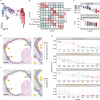Spatiotemporally resolved transcriptomics reveals the cellular dynamics of human retinal development
- PMID: 40055379
- PMCID: PMC11889126
- DOI: 10.1038/s41467-025-57625-9
Spatiotemporally resolved transcriptomics reveals the cellular dynamics of human retinal development
Abstract
The morphogenesis and cellular interactions in developing retina are incompletely characterized. The full understanding needs a precise mapping of the gene expression with a single-cell spatial resolution. Here, we present a spatial transcriptomic (ST) resource for the developing human retina at six developmental stages. Combining the spatial and single-cell transcriptomic data enables characterization of the cell-type-specific expression profiles at distinct anatomical regions at each developmental stage, highlighting the spatiotemporal dynamics of cellular composition during retinal development. All the ST spots are catalogued into consensus spatial domains, which are further associated to their specific expression signatures and biological functions associated with neuron and eye development. We prioritize a set of critical regulatory genes for the transitions of spatial domains during retinal development. Differentially expressed genes from different spatial domains are associated with distinct retinal diseases, indicating the biological relevance and clinical significance of the spatially defined gene expression. Finally, we reconstruct the spatial cellular communication networks, and highlight critical ligand-receptor interactions during retinal development. Overall, our study reports the spatiotemporal dynamics of gene expression and cellular profiles during retinal development, and provides a rich resource for the future studies on retinogenesis.
© 2025. The Author(s).
Conflict of interest statement
Competing interests: The authors declare no competing interests.
Figures






References
-
- Gregory-Evans, C. Y., Wallace, V. A. & Gregory-Evans, K. Gene networks: dissecting pathways in retinal development and disease. Prog. Retin Eye Res.33, 40–66 (2013). - PubMed
MeSH terms
LinkOut - more resources
Full Text Sources

